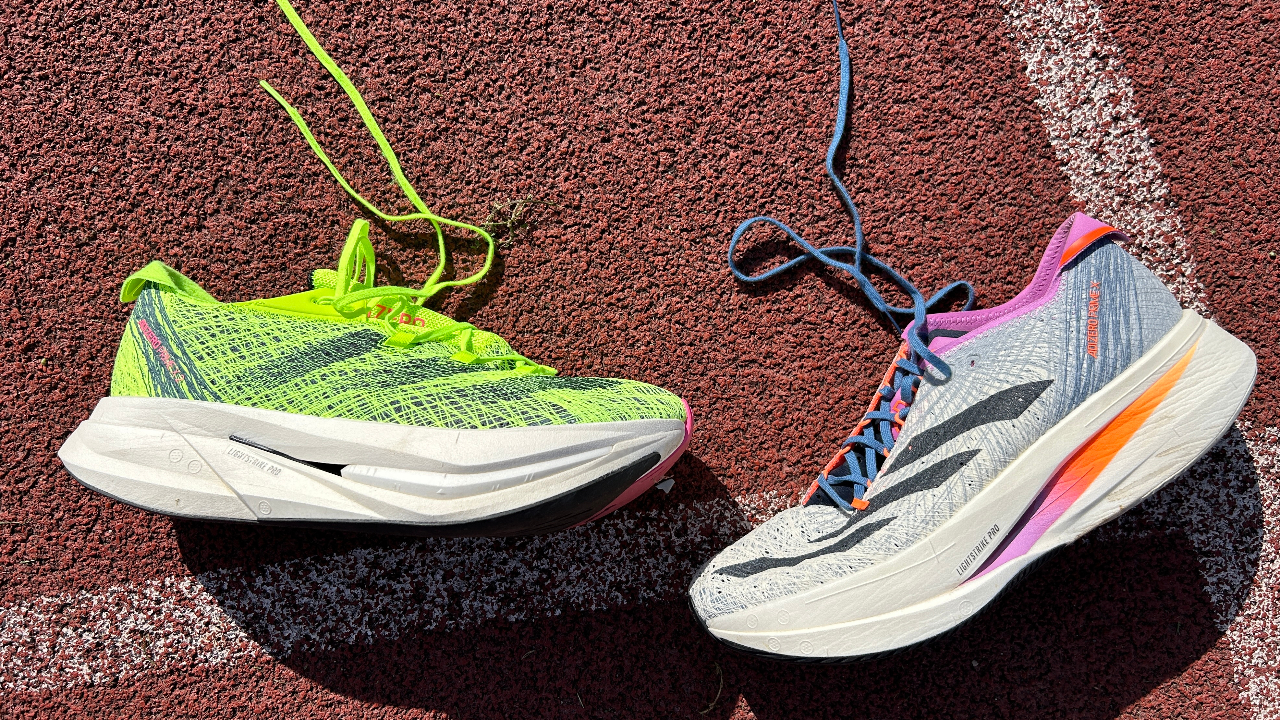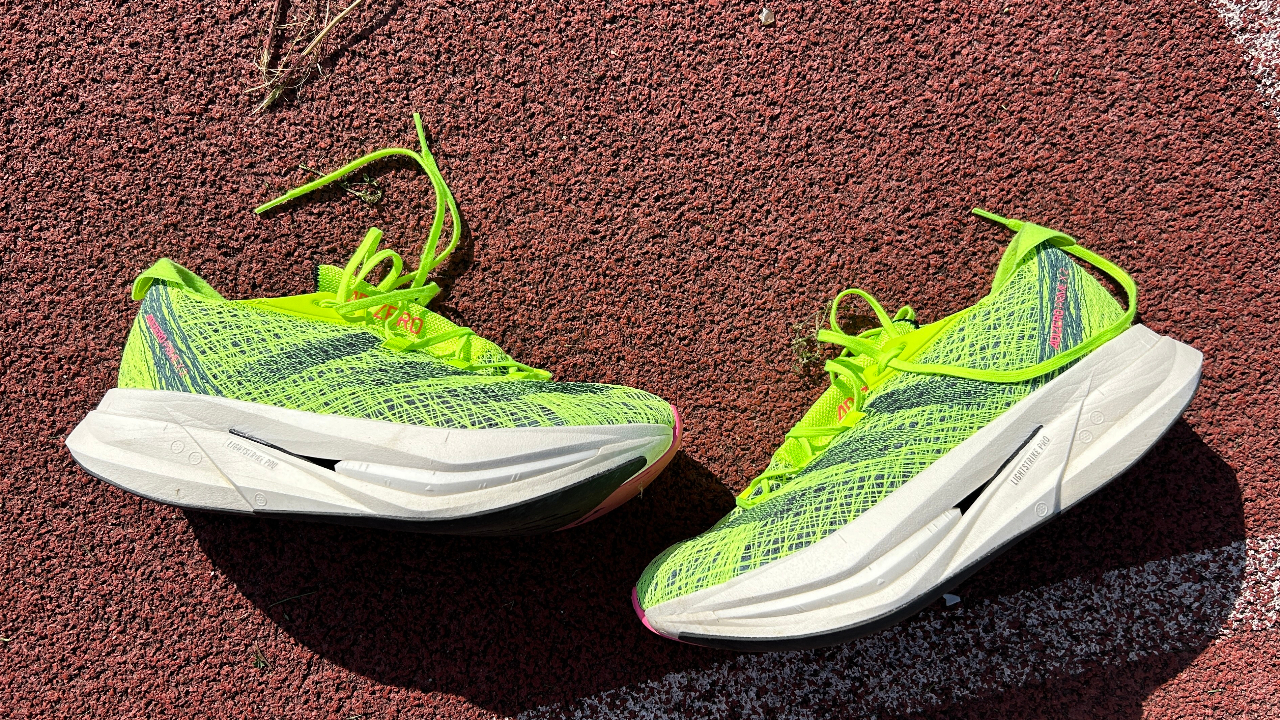Our Verdict
The Adidas Prime X 2 Strung is great fun to run in, and it’s much faster than its size and weight would suggest. However, it isn’t a better racing option than shoes that do meet World Athletics’ standards and, unless you have deep pockets, it’s too expensive to add as your daily trainer.
For
- More stable than Prime X
- As bouncy as it gets
- Fun for a variety of runs
Against
- Expensive
- Not better than “legal” shoes
- Still somewhat unstable
You can trust Coach
The Adidas Adizero Prime X Strung was a fantastic shoe—but one I had major problems with. One issue was the instability, the other was that the loose fit at the heel rubbed my achilles raw. The Adidas Prime X 2 Strung has fixed both these problems, but the changes made come with their own drawbacks in that it is heavier than its predecessor.
That means I wouldn’t pick it for races ahead of the best carbon plate running shoes, even if I was happy to race in a shoe that breaches the 40mm stack height limit set by World Athletics. This limit is mainly for elite athletes chasing wins and world records, rather than amateurs chasing PRs, though I wouldn’t feel comfortable racing in the Prime X 2 Strung even as a quick amateur.
Adidas Adizero Prime X 2 Strung: Price And Availability
The Adidas Prime X 2 Strung launched in September 2023 and costs $300 in the US and £250 in the UK. That makes it even more expensive than the Adidas Adizero Adios Pro 3, which is the most popular “legal” racing shoe in its line-up, though cheaper than the Adidas Adizero Pro Evo 1, which is $500/£400. I got my review sample of the Adidas Prime X 2 Strung from SportsShoes.
How I Tested This Shoe

I’ve run just more than 30 miles (around 50km) in the Adidas Prime X 2 Strung, using it for a mix of easy and steady daily training runs, plus a track session where I also used the original Prime X Strung as a guide. I’ve also tested most of the best carbon plate running shoes available.
Design And Fit
The signature feature of the Prime X line is the tall midsole, which hits 50mm at the heel and 43.5mm at the forefoot for a 6.5mm drop. That’s a slight increase in stack and drop on the 49.5mm/39.5mm of the original Prime X Strung.
With all that room available in the midsole Adidas has been able to cram in two carbon-infused plates, which are sandwiched by three layers of its bouncy Lightstrike Pro foam. There’s a lot going on in there, and it’s a different set-up from the first Prime X Strung, which used Adidas EnergyRods and TPU plastic EnergyBlades rather than two plates.
The shoe has an aggressive forefoot rocker and adds stability compared with the original Prime X through a wider design and by having foam running all the way down the medial size of the shoe—the Prime X had a cut-out here to reduce weight.
Sign up for workout ideas, training advice, reviews of the latest gear and more.

Weight is a talking point with the Prime X 2 Strung because it weighs 11oz/313g in my UK size 9, a jump from the 9.4oz/266g that the original weighed in the same size. The extra bounce you get from the two carbon plates in the new shoe offsets some of this weight gain, but it makes the Prime X more than 1.7oz/50g heavier than most legal racing shoes, and more than 3.4oz/100g heavier than the Nike Vaporfly 3 in my size.
Adidas has made changes to the shoe’s upper, which now has a stretchy, knitted section instead of a tongue to create a bootie-style design. It still uses the Strung layered yarns for the rest of the upper, and the padding at the heel feels unchanged, though I found the fit much better overall. There was no rubbing at the heel and the midfoot hold was more secure than with the original Prime X, making the Prime X 2 feel more stable when running fast. I wore my usual running shoe size for the shoe.
The outsole is made from Continental rubber and there’s good coverage across the shoe, with just a small central section left exposed. Cut-outs on the bottom of the shoe show off the plates within the midsole, while keeping the weight down.
Running Performance
There aren’t any other shoes that feel like the Adidas Prime X 2 Strung, which is even springier than the original shoe. The increase in stability with the new shoe is notable straight away, and I enjoyed using it for pretty easy daily training runs on suboptimal terrain, such as cambered paved surfaces and potholed roads. I felt obliged to stick to flat, pristine asphalt as much as possible with the original Prime X Strung, which only really felt good for fast runs.
That said, you get a lot more from the Prime X 2 Strung when you are running quick, and when I did a series of progression runs moving from easy to steady pace in the shoe it was noticeable how much bouncier and fun it felt at the faster end of things. It’s still less stable than more traditional, lower shoes, but it never felt worryingly wobbly on my runs.

You don’t have much ground feel in the shoe, and this means it can be hard to gauge your pace. I was nearly always moving faster than I expected, and as with all the best carbon plate shoes, the Prime X 2 Strung made quicker paces easier to maintain. I ran a progression 10K finishing at 3min 30sec/km pace—my marathon pace—with the second half of the run in 18 minutes, and it felt like I’d barely moved past easy pace.
Throughout these runs the weight of the Prime X 2 Strung wasn’t a factor. It’s a big shoe, but the bounce compensates for the weight when moving at speeds ranging from easy up to around my marathon race pace.
When I took it to the track for a workout running mile and 400m reps, however, the added weight was noticeable, especially when I swapped to the first Prime X Strung halfway through the workout. The older shoe is lighter and faster, and if you were intending to use the Prime X Strung for races then the original is the better option. I’d prefer pretty much any of the best carbon racing shoes of legal height to the Prime X 2 Strung, either for racing or speedy training sessions.
Is The Adidas Prime X 2 Strung Worth It?

The Adidas Prime X 2 Strung feels phenomenal at times, and nothing else is as bouncy and fun for cruising through runs. However, while it can do a lot of different kinds of run well, it doesn’t feel outstanding for really fast stuff and, given the high price, that’s a problem.
Whether or not you want to abide by the regulations I wouldn’t recommend the Adidas Prime X 2 Strung as a top racing option. Shoes like the Nike Alphafly 2, Adidas Adios Pro 3 and Mizuno Wave Rebellion Pro are not as outlandishly tall and bouncy, but are still bouncy and fast, and much lighter. They’re better racing options at any distance, as is the first Prime X Strung if you can handle its instability.
The Adidas Prime X 2 Strung feels more like a super-trainer to me, and it is a fantastic super-trainer that will bring joy to many everyday runs. There is still some instability to consider, though I don’t think it’s a huge problem for neutral runners, and you will notice how much fresher you feel during, and after, hard runs.
All of that comes at a high price, and there are tremendous all-rounders available for considerably less, including the Saucony Endorphin Speed 3 and Adidas Adizero Boston 12, which are more grounded and practical for daily use.

Nick Harris-Fry is a journalist who has been covering health and fitness since 2015. Nick is an avid runner, covering 70-110km a week, which gives him ample opportunity to test a wide range of running shoes and running gear. He is also the chief tester for fitness trackers and running watches, treadmills and exercise bikes, and workout headphones.

